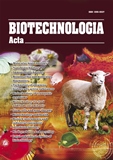ISSN 2410-7751 (Print)
ISSN 2410-776X (Online)

Biotechnologia Acta Т. 18, No. 3, 2025
P. 58-64, Bibliography 18 , Engl.
UDC 616.9,614.4,578.7
doi: https://doi.org/10.15407/biotech18.03.058
A SINGLE – CENTER STUDY ON THE INCIDENCE OF PCR–DETECTED INFLUENZA A/B RNA IN PATIENTS WITH SEVERE ACUTE RESPIRATORY DISEASE (2015-2019)
Matsas O.Y., Vorobiova O.V., Mulkina O.I., Slobodianiuk O.M.
St. Michael's Clinical Hospital, Kyiv, Ukraine
Influenza virus infection remains the leading cause of morbidity and mortality in the autumn-winter period. Along with insights into circulating virus subtypes and seasonal trends, reliable data on the prevalence of influenza among patients with acute respiratory illnesses is essential for guiding the selection of strains for annual vaccines and for optimizing the planning of immunization programs.
Aim. To perform a molecular diagnostic analysis of influenza in patients with severe acute respiratory illness between 2015 and 2019.
Methods. A total of 505 patients presenting with symptoms of severe acute respiratory illness and hospitalized at St. Michael’s Clinical Hospital in Kyiv were included in the study. Influenza A and B virus RNA was detected using real-time PCR.
Results. During the observation period, 49% of patients tested positive for influenza. The highest positivity rate (86%) was recorded in the 2017–2018 season, with influenza B virus being the predominant strain. In contrast, influenza B virus RNA was not detected during the 2015–2016, 2016–2017, and 2018–2019 seasons. The incidence of influenza A virus during those periods was 28.1%, 50.7%, and 25.4%, respectively. No co-infections were detected.
Conclusions. Influenza A virus circulated consistently among patients hospitalized with severe respiratory illness throughout all four seasons from 2015 to 2019. The sharp increase in influenza positivity observed during the 2017–2018 season is attributed to an outbreak of influenza B.
Keywords: autumn - winter epidemic period, acute respiratory diseases, influenza A, B viruses, PСR diagnostic.
© Palladin Institute of Biochemistry of the National Academy of Sciences of Ukraine, 2025
References
1.WHO (2018). Influenza (seasonal) factsheet. Available at http://www.who.int/mediacentre/factsheets/fs211/en/
2. European Centre for Disease Prevention and Control. Seasonal influenza key messages. (2017). Nov 16.
https://ecdc.europa.eu/en/seasonal-influenza/facts/key-messages
3. The WHO Mortality Database. (2016, December). https://www.who.int/
4. Snacken, R., Broberg, E., Beauté, J., Lozano, J. E., Zucs, P., Amato-Gauci, A. J. (2014). Influenza season 2012-2013 in Europe: moderate intensity, mixed (sub)types. Epidemiology and Infection, 142(9), 1809–1812. https://doi.org/10.1017/S0950268814001228
5. Chowell, G., Miller, M. A., Viboud, C. (2008). Seasonal influenza in the United States, France, and Australia: transmission and prospects for control. Epidemiology and Infection, 136(6), 852–864. https://doi.org/10.1017/S0950268807009144
6. Bosevska, G., Mikik, V., KondovaTopuzovska, I., Panovski, N., Collaborators. (2007). National Laboratory Surveillance of Influenza in Macedonia during Four Seasons. Central European Journal of Public Health., 25(3), 228-234. https://doi.org/10.21101/cejph.a4272
7. Pérez-García, F., Vásquez, V., de Egea, V., Catalán, P., Rodríguez-Sánchez, B., Bouza, E. (2016). Influenza A and B co-infection: a case-control study and review of the literature. European Journal of Clinical Microbiology & Infectious Diseases: official publication of the European Society of Clinical Microbiology, 35(6), 941–946. https://doi.org/10.1007/s10096-016-2620-1
8. Chattopadhyay, I., Kiciman, E., Elliott, J. W., Shaman, J. L., Rzhetsky, A. (2018). Conjunction of factors triggering waves of seasonal influenza. eLife, 7, e30756. https://doi.org/10.7554/eLife.30756
9. Krammer, F., Smith, G. J. D., Fouchier, R. A. M., Peiris, M., Kedzierska, K., Doherty, P. C., Palese, P., Shaw, M. L., …, García-Sastre, A. (2018). Influenza. Nature Reviews. Disease Primers, 4(1), 3. https://doi.org/10.1038/s41572-018-0002-y
10. Chagvardieff, A., Persico, N., Marmillot, C., Badiaga, S., Charrel, R., Roch, A. (2018). Prospective comparative study of characteristics associated with influenza A and B in adults. Medecine et Mmaladies Infectieuses, 48(3), 180–187. https://doi.org/10.1016/j.medmal.2017.11.007
11. Parrish, C. R., Murcia, P. R., Holmes, E. C. (2015). Influenza virus reservoirs and intermediate hosts: dogs, horses, and new possibilities for influenza virus exposure of humans. Journal of Virology, 89(6), 2990–2994. https://doi.org/10.1128/JVI.03146-14
12. Fox, S. J., Miller, J. C., Meyers, L. A. (2017). Seasonality in risk of pandemic influenza emergence. PLoS Computational Biology, 13(10), e1005749. https://doi.org/10.1371/journal.pcbi.1005749
13. Arbeitskreis Blut, Untergruppe «Bewertung Blutassoziierter Krankheitserreger» (2009). Influenza Virus. Transfusion Medicine and Hemotherapy : Offizielles Organ der Deutschen Gesellschaft fur Transfusionsmedizin und Immunhamatologie, 36(1), 32–39. https://doi.org/10.1159/000197314
14. Liang Y. (2023). Pathogenicity and virulence of influenza. Virulence, 14(1), 2223057. https://doi.org/10.1080/21505594.2023.2223057
15. Le, B. M., Presti, R. (2009). The current state of viral diagnostics for respiratory infections. Missouri Medicine, 106(4), 283–286.
16. Boktor, S. W., Hafner, J. W., Doerr, C. (2023). Influenza (Nursing). In StatPearls. StatPearls Publishing.
17. Mahony, J. B., Petrich, A., Smieja, M. (2011). Molecular diagnosis of respiratory virus infections. Critical Reviews in Clinical Laboratory Sciences, 48(5-6), 217–249. https://doi.org/10.3109/10408363.2011.640976
18. Adlhoch, C., Snacken, R., Melidou, A., Ionescu, S., Penttinen, P. European Influenza Surveillance Network (2018). Dominant influenza A(H3N2) and B/Yamagata virus circulation in EU/EEA, 2016/17 and 2017/18 seasons, respectively. Euro Surveillance: Bulletin Europeen sur les Maladies Transmissibles = European Ccommunicable Disease Bulletin, 23(13), 18-00146. https://doi.org/10.2807/1560-7917.ES.2018.23.13.18-00146

